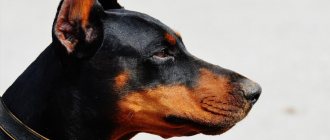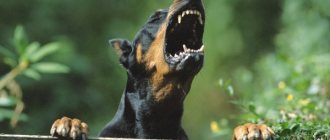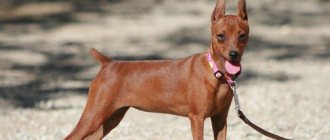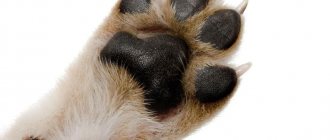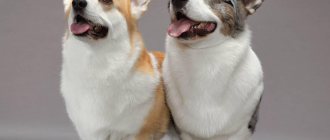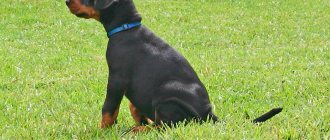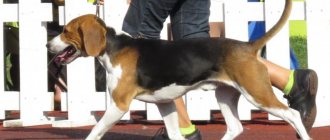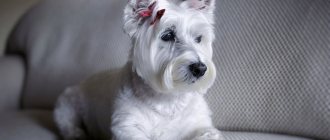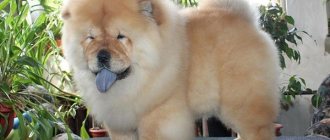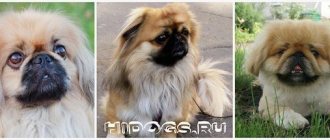Many people remember very well Glyukoza’s cartoon clip about the bride, where a cartoon teenage girl easily manages a large and majestic dog on a walk. This dog is a Doberman Pinscher breed. This breed will be discussed in the article.
A young breed developed in the second half of the 19th century and named after the breeder Louis Doberman. Carrying out numerous searches to obtain a dog that, becoming an excellent protector for the owner, would retain the elegance of its appearance.
Louis had to cross four breeds: a miniature pinscher, a Rottweiler, an English greyhound, and a German shepherd. There is a little bit of admixture from other breeds, but these breeds have given the main traits to this strong dog. Typically, dogs of this breed are used for service purposes. Very smart, easy to train, unrivaled guards. Their appearance is menacing and intimidating, but their disposition is very friendly, although they are always serious. They love to chase and drive the pursued object into a corner, where, without attacking, they will hold it until the owner arrives.
Doberman Pinscher
A very large animal, with a well-developed, muscular body. A healthy animal will delight its owner with its presence in his life for 8 - 12 years. Males in adulthood reach large sizes, their height at the withers is 68 - 72 cm, ladies are slightly smaller and are 63-68 cm at the withers.
Fit, with long graceful paws, the weight of an adult Doberman male reaches 40-45 kg; females are lighter and usually weigh no more than 35 kg. The best representatives of the breed are dogs with average performance.
The proud posture of the animal is added by cropped ears, which give it a special, intimidating appearance. Ear cutting is performed on puppies at 7-8 weeks of age. The coat color is usually brown or black. Dobermans are smooth-haired dogs. Their fur fits so tightly to the body that it shines in the sun in different colors. The presence of undercoat is not allowed. They always have red tan markings located above the eyes, on the chest, cheeks, paws and under the tail. According to the standard, the head from above should look like a blunt wedge.
A standard table has been adopted, according to which puppies of the breed in question should gain weight by month. In order for your pet to meet the standards, you need to carefully monitor the diet and select nutrition. Puppies grow very quickly, increasing in size several times each month.
| Boys: | Girls: | |
| 1 month | 3.8 kg | 3.5 kg |
| 2 month | 8.7 kg | 7.8 kg |
| 3 month | 14 kg | 12.3 kg |
| 4 month | 18.5 kg | 16.5 kg |
| 5 month | 22.5 kg | 20.3 kg |
| 6 month | 26 kg | 23 kg |
| 7 month | 27.5 kg | 24.5 kg |
| 8 month | 29.5 kg | 25.6 kg |
| 9 month | 31.2 kg | 26.6 kg |
| 10 month | 33 kg | 27.5 kg |
| 11 month | 34 kg | 28 kg |
| 12 month | 35 kg | 29 kg |
Overweight of the animal should also not be allowed. If this happens, it is necessary to transfer him to dietary nutrition.
Description of the breed
The Doberman is a large, muscular dog with an elegant build. His constitution is far from coarse and massive.
Standard:
- Dimensions: height - up to 68 cm, weight - up to 45 kg.
- The body is square, clearly defined.
- The skull is strong and of good proportions. When viewed from above, it resembles a blunt wedge. The head has pronounced muscles.
- The muzzle is set deep. In black colors the nose is black, in lighter colors it is brown. The lips fit well to the jaw and are tightly closed. Scissor bite. The teeth are white and strong.
- The eyes are oval and brown.
- The ears are set high; if cropped, they stand up. Some states prohibit ear cropping. In this case, they should be hanging, adjacent to the cheeks.
- The neck is long, muscular, with a graceful curve.
- The withers are clearly defined. The back is strong, rather short.
- The chest is wide and round, slightly protruding forward.
- The tail can be docked or natural. In the first case, it is stopped up to the second vertebra.
The coat is short, hard, without undercoat. Colors:
- black;
- white;
- yellowish brown;
- blue;
- red.
The white color is caused by a gene mutation and is a violation of the standard. It is accompanied by a number of physical and mental pathologies, so white Dobermans are not allowed to reproduce.
Miniature Pinscher Miniature Doberman
Despite the name "dwarf Doberman", the miniature pinscher is not an exact copy of the Doberman in a smaller form. Referring to an independent breed of dogs, they are united with the Doberman by one common ancestor of the smooth-haired pinscher breed. This is where the similarities end. This breed has a second name - miniature pinscher. The Miniature Pinscher is a breed older than the Doberman Pinscher. Its origin dates back to the 15th century.
A born hunter, with sensitive hearing and an excellent sense of smell, he will perfectly cope with the role of a devoted friend in the family and a reliable guard. A smart dog, even as a puppy, will figure out who is prey and who is master and friend, and does not need long and tedious explanations. Hunting instincts are perfectly preserved, even if the animal lives in an urban environment.
At the end of the 19th century, the miniature pinscher standard was determined. An animal with a muscular body, an elongated muzzle and powerful jaws. They have a thin but very strong neck, medium-sized and erect ears. Very proportional dogs, at sexual maturity reaching a height of 25-30 cm at the withers for males, females are a couple of centimeters lower. The weight of an adult dog is 4-6 kg. In males, girls weigh less. Despite its modest size, this is a very strong breed of dog. The coat is smooth, dense, and the color is brown, or less commonly black and tan. The life expectancy of little hunters reaches 15 years.
Puppies grow very smoothly, gradually gaining weight over the months:
| Age: | Weight: |
| 1 month | 0.65 kg |
| 2 months | 1.1 kg |
| 3 months | 1.5 kg |
| 4 months | 1.9 kg |
| 5 months | 2.3 kg |
| 6 months | 2.5 kg |
| 12 months | 4 kg |
Pros and cons of Dobermans
Among dog breeders there are many lovers of this breed; but there are also those who, under no circumstances, agree to take a Doberman into their home. In both cases, the choice is justified by the characteristics of the “German aristocrats.”
The following characteristics can be considered as the advantages of the breed:
- The versatility of the Doberman. The breed is actively involved everywhere, except for systematically lying in front of the TV. The Doberman is suitable for all types of service and security spectrum, as well as for all kinds of search and rescue work. Moreover, European dog handlers actively use these dogs in the implementation of social projects (Dobermans are excellent guide dogs for the blind);
- Devotion to the owner. Brave, courageous Dobermans always follow the leader - through thick and thin. Pay attention - behind the leader;
- Highest intelligence. This breed is rightfully considered the smartest, and the statement cannot be considered unfounded. In the book “The Intelligence of Dogs” by S. Koren, the Doberman is included in the group of breeds with excellent training abilities. Therefore, training and service are the best time of life for these noble and elegant dogs;
- Power, endurance, fortitude. The Doberman is a real “fighting machine”: Hollywood may exaggerate, but here he is definitely not lying.
Dobermans also have disadvantages - you need to familiarize yourself with them no less carefully than with the advantages, because it is better not to adopt a dog than to bring a Doberman puppy into your home and not cope with its upbringing.
So, the disadvantages of the breed:
- The Doberman is not for everyone. These dogs only accept charismatic, strong people - real leaders. Lethargic, spineless phlegmatic people will under no circumstances cope with this German campaigner;
- Stubbornness and pronounced willfulness. An intelligent and capable Doberman always has his own point of view on everything - only when communicating with someone whom he recognizes as a leader, does he keep his opinion “to himself”;
- Dobermans are incredibly pugnacious and aggressive. Actually, this is one of the necessary components of the “police breed”;
- “Dobers” cannot imagine their life without systematic physical activity and high, intense, long-term stress. An unathletic, soft-bodied couch potato definitely doesn’t need a Doberman - but a St. Bernard or a collie would be perfect.
If your Doberman puppy is not gaining weight
The current weight gain standard for Doberman Pinschers is the same for all dogs of this breed. As the puppy develops, it should gain weight proportionately. If the pet deviates from the set rate of weight gain, the owner should pay attention to this and monitor the dog’s behavior.
Abnormalities in weight gain can be a sign of certain diseases, but not always. Active animals that love to run and whose owners spend a lot of time walking with them gain weight more slowly.
Climate also affects this indicator. It is necessary to ensure that the puppy receives enough calcium from its diet. Infectious and viral diseases can prevent weight gain. The presence of worms is always the reason for slow weight gain.
Training and education
The Doberman is a large, self-sufficient dog that requires proper training. The success of parenting depends on mutual respect. The dog must understand that the owner is the head of the hierarchy. This does not negate the care and affection on the part of the owner. If an animal trusts its owner's decisions, it will follow any orders. Training begins from the first months of life. The puppy must learn simple commands, get used to eating, sleeping and walking. It is important to introduce him to the world around him in time. The baby should often be taken for walks in public places. Particular attention is paid to zoo aggression. The Doberman must react loyally to its relatives and know the command to me.
Adult male dogs love to get into fights, so the owner must take care of the safety of those around him. In case of increased aggressiveness, it is better not to let the dog off the leash and not to take it outside without a muzzle. Self-walking is strictly prohibited!
Dobermans are incredibly smart. They make excellent investigators, surpassing German Shepherds in detection. Puppies are trained in this work from two months. To realize the potential of this breed, it is recommended to enroll your baby in group classes with a dog handler. A general training course will not only make the dog manageable and flexible, but will also give impetus to subsequent development. Dobermans are very successful at agility and love to multitask.
How to gain weight for a Doberman puppy
A healthy dog has an excellent appetite, and the rate of weight gain directly depends on the diet of the growing dog. You cannot feed your dog raw meat. It is necessary to take into account that the animal is very large, and eating raw meat leads to increased aggressiveness. The best diet would be dry food. About half a kilogram of food per day will provide your pet with the necessary microelements.
You can feed a Doberman with natural food, but you need to take into account some features. Pork is not the best food for these dogs, at least lean.
By-products can be given, but after reaching 6 months. An excellent diet would be a diet with a predominance of dairy products: cottage cheese, kefir, yogurt. Dobermans love raw eggs and fish. Giants really need microelements, of which there are many in cereals: millet, oatmeal, rice and buckwheat will perfectly compensate for their deficiency. Vitamin supplements should be added to the diet with natural food.
Diseases and life expectancy
Doberman Pinschers are known for their relatively good health. At the same time, their breed diseases are varied and form a frightening list:
- dysplasia of the hip and elbow joints;
- volvulus;
- compression of the cervical vertebrae;
- vitiligo;
- cataract;
- diabetes;
- baldness;
- hypothyroidism;
- melanoma;
- cataract;
- fibrosarcoma;
- von Willebrand disease;
- cutaneous histiocytoma.
Average life expectancy: 12-15 years.
How to dial and measure height correctly
It is not on a whim that breeders instill certain standard traits into dogs, for which strict parameters are established. The presence of these features helps animals cope with the main tasks of their breeding, i.e. security functions, hunting, decorative.
Accordingly, parameters for measuring standardized indicators and special tools for making measurements have been established. The most accurate measurements are taken with a rigid measuring stick. A less accurate tool, where the error increases, includes a flexible measuring tape.
A book or any flat object is applied to the withers of a dog standing on a flat, level surface, while its head should be raised and its neck straightened. A flat object located at the withers is pressed against the wall at one end and a mark is made at this level (approximately the way we were measured in childhood).
The resulting level is measured with any of the above instruments. The greatest accuracy is obtained by measurements taken three times.
Character traits
The modern Doberman does not show aggression unless necessary. If previously among representatives of this breed there were animals with an unstable psyche, by now, thanks to the efforts of breeders, this defect has been almost completely eradicated.
The Doberman has all the qualities of an excellent service dog. He has a stable nervous system, he is fearless and well trained. This is an energetic, dexterous, agile, sensitive and moderately angry dog, whose behavior can be described as calm, attentive and distrustful of strangers.
At home, these dogs are calm and friendly. A properly raised Doberman with a good psyche is loyal to other animals and children .
Expert opinion
Kozhevin Semyon Kirillovich
Expert dog handler.
The German Doberman is a wonderful guard dog for a private home or apartment. True, it is impossible to keep these dogs outside all year round due to their short hair, and this must be taken into account when keeping them. They rarely get sick and, as a rule, are in good health and live long enough. In terms of maintenance, the Doberman is completely unpretentious, and caring for him is easy.
Briefly about the main thing
- The ferocious appearance of the Doberman is just a frightening picture. Of course, he is a very strong animal, capable of protecting his owner to the end, but by his nature he is friendly and accommodating.
- They will make great friends for teenagers and get along well with smaller animals in the house. They love communication very much, and even need it. Owners must allocate enough time to communicate with their pet.
- Smart, easily trained dogs, designed for human protection.
- An interesting fact about the miniature pinscher: racing over huge distances is the norm for them, because they used to accompany carts with horses to protect the property of their owners.
- An excellent mole and rat catcher.
- Its modest size is complemented by the complex character and abilities of a security guard.
- Already as a puppy, he should know that the owner is in charge.
- Active, playful, friendly, but with dignity. They cannot stand violation of their boundaries and pain.
- Capable of barking until they are hoarse.
Origin story
The Doberman Pinscher is a signature breed, bred in Germany in 1890. Its creator was Karl Dobermann, a night policeman and tax collector. During his off-hours, he helped homeless dogs and even founded his own shelter. Dobermann's position was fraught with constant danger and aggressive defaulters. The policeman needed a loyal bodyguard, but none of the known breeds had the desired qualities. Then Karl Dobermann decided to do his own breeding in order to breed the ideal protector dog.
The policeman carefully selected the “material” for his work: he traveled to fairs and farms to find suitable dogs. Despite the fact that Dobermann was not a professional breeder, he managed to develop a full-fledged breed suitable for his purposes in just 20 years. Already in 1870, the so-called Thuringian Pinschers appeared - the ancestors of the modern Doberman. These dogs had valuable working qualities and gained fame as natural bodyguards. They began to be used for police service and farm security.
Thuringian Pinschers were bred from Great Danes, Rottweilers, German Shepherds and German Smooth Pinschers.
In 1894, the author of the breed, Karl Dobermann, died and the Thuringian Pinschers changed their name to Doberman Pinschers. After 3 years, the first monobreed exhibition took place, where dogs were presented according to all the rules. In 1949, amendments were made to the breed standard: the name was changed to Doberman.
